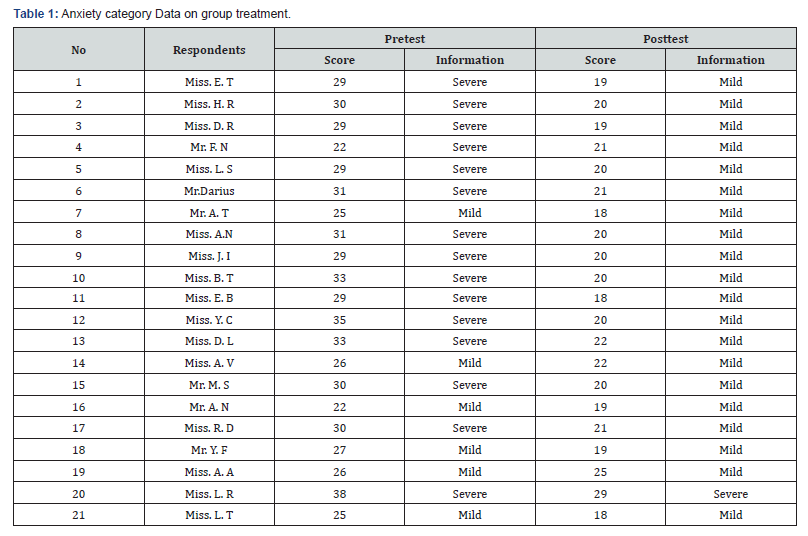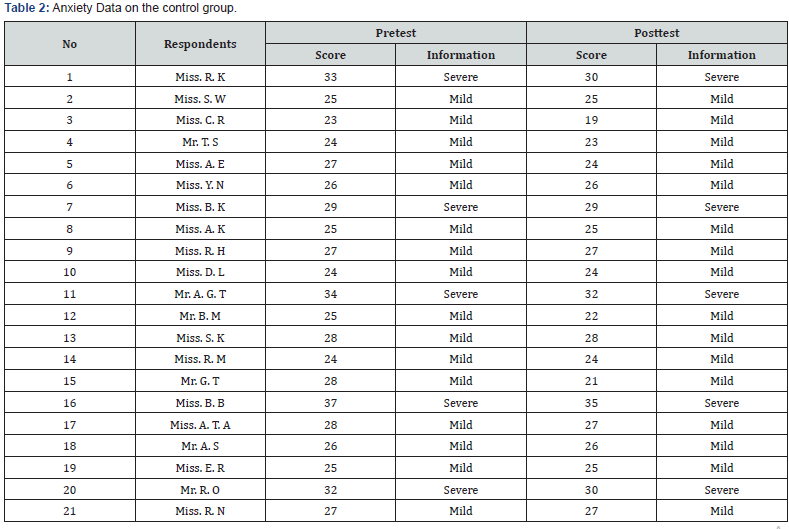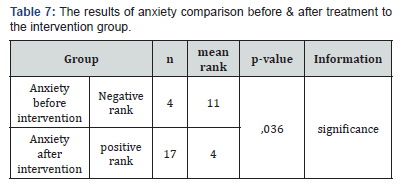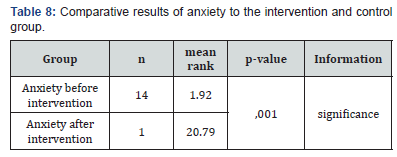Anatomy Physiology & Biochemistry - Juniper Publishers
Abstract
Background: According to the elderly World
Health Organization (WHO) is a group of people aged 60 years or older.
Mental or psychic changes in the elderly can be an increasingly
egocentric attitude, easy to suspect, grow stingy or greedy when having
something. There are several types that can be used to reduce the
anxiety of elderly like music which can be applied as interventions to
alleviate anxiety. It has been proven that the music compiled by Bach,
Mozart, and other Italian composers is the most effective in providing
distraction effects in patients.
Method: the type of research used is Quasi experiments that have treatment or pre and posttest design.
Result: there is a very strong correlation as
there is a decreased in anxiety levels in the elderly after given
classical music therapy with a value of T-test of 0.001.
Discuss:Classical music therapy can be given
to elderly patients who are hospitalized or in a nursing home or elderly
confound. It can be a reference material or a reference in providing
intervention to elderly patients with anxiety disorders.
Keywords: Geriatric anxiety classical music therapy elderly compound.
Background
According to the elderly World Health Organization
(WHO) is a group of people aged 60 years or older. According to law of
Ministry of Health No. 13 of 1998 about the welfare of the elderly in
Chapter 1 of article 1 paragraph 2, the elderly is a person who reaches
the age of 60 years and above. According to the World Health
Organization (WHO), in 2015, the world population is 60 years or older,
reaching 900 million. Today, there are 125 million people aged 80 years
or older, in 2050, estimated to reach 2 billion people around the world.
Nearly as many as 120 million people live alone in China, and 434
million are in this age group worldwide. In the Southeast Asian region
the elderly population is 8% or about 142 million people. In 2000 the
number of elderly around 5.3 million (7.4%) Of the total population, and
the year 2020 is estimated the number of elderly 28.8 million (11.34%)
of the total population (Ministry of Health, Republic of Indonesia,
2013). Population of Indonesia by age group and gender, age
group of 45-49 years the number of males 8,352,946 inhabitants while
the number of women 8,304,021 inhabitants, age group of 50-54 years the
number of males 7,064,237 the number of female women 7,114,776 souls,
Age group 55-59 years male number
5,737,258 Soul number female 5,719,813 soul, age group 60-64 year male
number 4,247,245 souls number of women 4,150,520, age group 65-69 years
male number 2,780,759 the soul number of women 2,962,002 people, the
group age 70-74 years of male number 1,817,892 total female population
2,145,584, age group > 75 year number of males 1,876,328 the number
of women of 2,650,552 people (Ministry of Health, Republic of Indonesia,
2016).
Mental or psychic changes in the elderly can be an
increasingly egocentric attitude, easily suspicious, increased stingy or
greedy when having something (Nugroho, 2012). The most common
psychological changes that occur and are most commonly experienced by
the elderly are anxiety, depression, insomnia and dementia (Maryam,
2011). Anxiety is an emotional state that does not have a specific
object, in the form of an obscure
worry, spreading, relating to the uncertain and helpless feelings
of Fear (Stuart, 2006) Anxiety is an unclear feeling of fear
and Not supported by the situation. Anxiety disorders are not
considered part of the normal aging process, but the changes
and challenges that elderly often face (such as chronic diseases,
cognitive disorders, emotional disorders) may contribute to the
development of symptoms and disorders Anxiety (Touhy, 2014). Basically all types of music can actually be used in an effort
to lower the anxiety level (Campbell, 2006). There are several
types of music that can be applied as interventions to reduce
anxiety, among others Music Cure, Mozart’s classical music,
classical music’s Four Seasons, classical music played along with
natural sounds (sea sounds, rain, and water sounds) as well as
other classical music that has been extensively researched by
researchers (Analyia & Moekroni, 2016; Heijden, Araghi, Dijk,
Jeekel & Hunink, 2015; Mohammadi, Ajorpaz, Torabi, Mirsane &
Moradi, 2014; Trappe, 2012). However, it is often recommended
to select music with a tempo of about 60 beats / minutes so that
the optimal resting state is obtained [1].
The most useful music for a patient’s health is classical music.
It has been proven that the music compiled by Bach, Mozart,
and other Italian composers is the most effective in providing
distraction effects in patients (Trappe, 2012). This is in line with the
research conducted by Muhammad Luqman Prihananda & Arina
Maliya (2011) entitled “Effect of classical music therapy on the
anxiety level of hemodialysis patients at the PKU Muhammadiyah
Hospital of Surakarta”, indicating the influence of classical music
therapy to the anxiety level in hemodialysis patients in hospital
pku Muhammadiyah Surakarta. The selection of classical music is
based on the belief of many experts that the rhythm and tempo of
most classical music follows a human heart rate speed of about 60
beats / minutes (Campbell, 2006). Patients who receive the most
benefit from classical music therapy include patients with anxiety,
depressive syndrome, and cardiovascular disorders and those
suffering from painful, stress or sleep disorders.
Based on the above background, researchers are interested
to do research to the elderly who live in the elderly compound in
Sentani District of Jayapura Regency to learn about the effect of
giving classical music therapy to elderly anxiety level [2].
Statement of the problem
Based on the background of the problem above, the problem
of this research is “is there any influence of classical music therapy
to the level of elderly anxiety in the home of the elderly compound
in Jayapura district?”
Method of Research
Health problem of foot
The type of research used is research quasi experiments that
have treatment. The research aims to reveal causal relationships
by involving control groups in addition to experimental groups,
but the selection of the two groups is not random. The research
also aims to clarify the cause of an event or both. With the design
used is a pre and post-Test control group design.
Result
Based on analysis data and test statistic carried out so that
the following results are described in the form of analysis of
univariate and bivariate.
Univariate analysis
1. Data degree of anxiety when Pretests and posttest on
group treatment
The table above shows that of the 21 respondents in the
treatment group when the pretests experienced the “severe
anxiety” category there are 14 elderly and the “mild anxiety”
category there are 7 elderly with the highest score of 38 and a
score of 22. After the treatment was given the music therapy,
the anxiety category during posttest in the treatment group
slightly decreased with “severe anxiety” 1 elderly, “mild
anxiety” 20 elderly with the highest score of 29 and the lowest
score of 18 (Table 1).

2. Data level of anxiety during pretests and posttest in
control group
The table above shows that of 21 respondents in the control
group when Pretests experienced the “severe anxiety”
category there are 5 elderly and “mild anxiety” there are 16
elderly with the highest score of 37 and the lowest score 23.
Without treatment is music therapy, anxiety categories during
posttest in the average control group did not suffer a decline
with the category of “severe anxiety” 3 elderly, “mild anxiety”
18 elderly with the highest score of 34 and the lowest score
19 (Table 2).

Data level of anxiety group treatment and control group when pretests
Based on the above table shows that the subject in the
treatment group is in severe anxiety as much as 14 people
(66.65%) and was in mild anxiety as much as 7 people (33.3%),
while in the control group who were in severe anxiety as much as
5 people (23.8%) and was in mild anxiety as much as 16 people
(76.2%) (Table 3).
Lameness scale
The American Association of Equine Practitioners (AAEP)
developed a lameness scale to aid veterinarians and horse owners
in communicating about cases and recordkeeping [30,31] (Table
1).

Data level of anxiety group treatment and group control during posttest
According to the table, it is known that the overall 21 subjects
of the treatment group were given treatment of classical music
therapy that was in severe anxiety as much as 1 person (4.76%)
And that is in mild anxiety as much as 20 people (95.24%), while
the level of anxiety in the control group without being given the
classical music therapy treatment of the whole subject of the
control group that was in severe anxiety as much as 4 people
(19.04%) And that was in mild anxiety as much as 17 people
(80.95%) (Table 4).

Bivariate analysis
Normality Test
Testing the normality of data distribution in this study is
using the Shapiro-Wilk method. Test data normality is intended
to determine the normality of the research data spread. Data
normality test calculation results can be seen in the table belowThe (Table 5) shows the results of the test Shapiro-wilk
normality which results in the value of a pretests variable of 0.012
and a posttest variable of 0.03 where the sig value is less than
0.05. This indicates that the pretests or posttest data is a normal
distribution (p > 0.05). Hypothesis testing for normal distribution
data using alternative tests of coupled T tests is Wilcoxon’s nonparametric
test [3].

Hypothesis testing
The hypothesis test used in this study was test-T,
since the
study tested two unpaired samples. This test was inserted to see
the classical effect of music therapy before and after the treatmentis
also seen the differences in the influence of classical music
therapy in the group treatment with control group to the level of
anxiety in the elderly (Table 6).

Other method of therapy
To make a decision whether a proposed hypothesis is received
or rejected, it is defined as follows: Ho is no influence of classical
music therapy before and after treatment is also a difference in
the influence of classical music therapy on group treatment with
control group to the level of anxiety that occurs in the elderly
compound in the district of Jayapura, Ha that there is the influence
of classical music therapy before and after given treatment also
differences of influence Classical music therapy in a group
treatment with a control group to the level of anxiety that occurs in
the elderly compound in Sentani Jayapura District. The hypothesis
test decision making criteria by comparing the probability value
(p) to α = 5%. The criteria of the decision are as follows: (1) when
p > 0.05 then Ho is accepted and Ha is rejected; (2) When P is <
0.05 then Ho is rejected and Ha is accepted. The overall hypothesis
test results are summarized and presented as follows
T-test results indicate that the P value obtained is 0.000. The
value turns out to be < 0.05, thus Ho is rejected and Ha accepted.
This means there is a significant difference in classical music
therapy between anxieties before the group treatment with
anxiety after the group’s treatment of the elderly. Based on the
research statistic data, positive rank or difference (positive)
between the anxiety before the treatment group and after the
treatment group is 0 positive data on the value n and the mean
rank that does not occur increased anxiety on seniors who are
given classical music therapy. While negative rank (negative)
between before the treatment group and after treatment group
is 21 at the value N and 11 in the mean rank which means there
has been decreased or reduction of anxiety in the elderly who are
given music therapy Classic (Table 7).

The result of T test shows that the value of P obtained is 0.036 the value is more than 0.05, thus Ho accepted and Ha rejected. This means there is a significant difference in classical music therapy against anxiety before intervention into the control group with anxiety after intervention to the control group. Based on the research statistic data, positive rank or difference (positive) between the anxiety before the control group and after the control group is 0 positive data on the value n and the mean rank that does not change of anxiety in the elderly which is given classical music therapy [4].
The result of T test shows that the value of P is 0.001. The value
was apparently less than 0.05, thus Ho was rejected and Ha was
accepted. This means there is a significant difference in classical
music therapy between anxieties after a group intervention with
anxiety after treatment of the control group (Table 8).

Discussion
The research aims to determine the effect of classical music
therapy on the level of anxiety in the elderly compound. Based
on the results of the research gained that the characteristics of
anxiety when pretests and posttest and at the treatment group
showed that of 21 respondents in treatment groups when
pretests experienced the category of “severe anxiety” there are
14 respondents and the category of “mild anxiety” there are 7
respondents with the highest score of 38 and a score of less 22.
After given the treatment is music therapy, the anxiety category
during posttest in the treatment group experienced a decline with
“severe anxiety” 1 respondent, “mild anxiety” 20 respondents
with the highest score of 29 and the lowest score 18.
Anxiety characteristics when pretests and posttest in the
control group show that of 21 respondents in the control group
when Pretests is experiencing “severe anxiety” category there are
5 elderly and “mild anxiety” there are 16 elderly with scores The
highest of the 37 and the lowest score 23. Without treatment is
music therapy, anxiety categories during posttest in the average
control group did not suffer a decline with the category of “severe
anxiety” 3 elderly, “mild anxiety” 18 elderly with the highest score
of 34 and the lowest score 19. Similar results correspond to the
research of Dina (2017) stating that with classical music therapy
treatment the category of anxiety in the elderly when posttest was
decreased.
Based on the results of research that can be from the test
analysis of T-test shows that the value of significance is 0.001. The test result showed smaller than 0.05. This means there is
a significant difference in music therapy between the group
treatment and the control group against anxiety. The elderly is
a person aged 60 and above both men and women, who are still
active in activity and work or those who are powerless to make
their own living so that it depends on others to live themselves. The
elderly is the process of gradually disappearance of the network’s
ability to repair itself or replace, maintain its normal functioning
so that it cannot withstand infections and repair damages.
Mental or psychic changes in the elderly can be an increasingly
egocentric attitude, easily suspicious, increased stingy or greedy
when having something (Nugroho, 2012). The most common
psychological changes that occur and are most commonly
experienced by the elderly are anxiety, depression, insomnia
and dementia (Maryam, 2011). It can be proved by the results
of this study which suggests that elderly can experience anxiety
with varying levels of anxiety whether it is mild anxiety as well as
severe anxiety [5]. Many ways can be used to handle the anxiety of one of them
by listening to music. According to Hawari (2011:53) Relaxation,
eating chocolate, sleep can restore all physical and mental fatigue;
in addition to that anxiety treatment can be done by listening to
music. Music therapy includes one of the handles in treating stress
and anxiety (Aizid, 2011:42). The music affects the decline in
sympathetic nerve control, decreased heart rhythm, respiratory
rate, metabolism, oxygen consumption and muscle tension.
Listening to classical music helps in reducing stress, while
listening to rock music enhances the rhythm of the Heart (John
et al, 2010:75).
Similar research also conducted by Kartinah (2013) said that
the analysis comparing the results before the therapy (pretest)
and after therapy (posttest) showed the influence of music
therapy on changes in the level of anxiety in the elderly. For some
respondents classical music has tones that can make the heart
comfortable when hearing it. Based on the results, there was a
difference in the level of anxiety influence in the treatment group
with the control group because most of the respondents were very
interested in classical music, and when respondents experienced
the respondent’s anxiety Do choose to listen to music and do other
activities to reduce its level of jealousy [6-8].
Summary
Based on the results of the research and discussion that has
been previously exposed, it can be concluded that the elderly tend
to experience high anxiety or weight due to the effects of aging and
psychological distress because they are far from the family. The
conditions of those living in the home and away from the family
will trigger for them to experience anxiety disorders. With this
research apparently provides an accurate solution to the elderly
to prevent or overcome their anxiety disorder with classical music
therapy about 15 minutes each time with a frequency twice daily.
To Know more about our Juniper Publishers





No comments:
Post a Comment